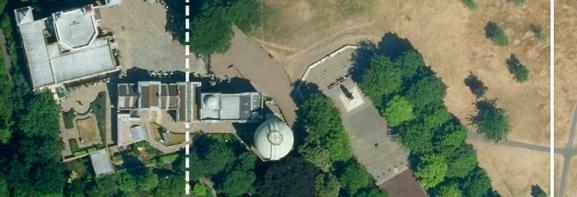
Prime Meridian 1854, dotted by GPS solid
Recently, it was reported that the Prime Meridian, as marked at the Royal Observatory in Greenwich, England, is off by 102 meters, over the length of an American football field. The Prime Meridian is the arbitrary line marking 0 degrees of longitude. All other longitude is notionally measured from the Prime Meridian. The Meridian was established by Sir George Airy in 1851 and now 164 years later, it appears that Airy got it wrong. So how could this sort of mistake have been made? How did they catch it? Does this mean that all other lines of longitude are also off by over 100 meters?
The answer to the last question is no. The mistake in calculating the position of the Prime Meridian does not effect any other calculation of longitude. No one actually measures directly from the Prime Meridian to any other point on the globe to determine longitude. The globe is too large to literally run a tape measure. So, longitude on the rest of the earth is still just as accurate as it was before.
How did they catch the error and how do we know that it is an error? A visitor using a modern handheld GPS noticed the discrepancy. The Global Positioning System (GPS) uses satellites to accurately measure grid coordinates at any point on the Earth’s surface. GPS is more accurate than older terrestrial methods for calculating a position on the earth.
So, to return to the first question, how could this sort of mistake have been made? Was it just a foul up? No. The calculations were right, as far as they went.
The basic calculation involved using a transit circle, an instrument for measuring star positions, to measure an exact angle between a given star and a notional line running vertically from the center of the earth. This should be simple, in that a plumb bob, a weight hanging from a string, should be drawn by gravity toward the center of the earth. It is as simple as up and down. Down is toward the center of the earth and up is toward the zenith of the sky.
The problem is that down is not always straight down. There is a phenomenon known as “deflection of the vertical.” It turns out that gravity is not quite uniform. It is affected by the the mass of mountains and underground geological irregularities. It causes gravity to not pull straight down toward the center of the earth. The difference can be as much as 10 degrees off what would otherwise be straight up and down. It so happens that a survey of the geography around Greenwich identified a deflection in gravity which accounts for the discrepancy. When Sir George Airy measured his angles, down was not quite straight down and therefore his meridian was about 100 meters misplaced.

See, your buildings are not plumb either, just don’t tell a carpenter!
His plumb Bob lies!
If you compare GPS coordinates to not so old-fashioned map coordinates anywhere in the world, it seems they would not match because the starting points don’t match. Or, if there were geological irregularities present at the time of their local original measurement. Wouldn’t these cause problems with matching GPS to coastal mapping, underwater hazards, or even cruise-missle targeting? Isn’t it probable that other points around the world could have the same original “errors”?
Phew! Having visited Greenwich on several occasions and straddled the Prime this was shocking news !!! Well anyway I had a 50 year professional career at sea and managed to navigate safely. GPS is grand but always take morning and evening star sights. Good Watch.
Instead of leap seconds, we now need 100 leap metres.